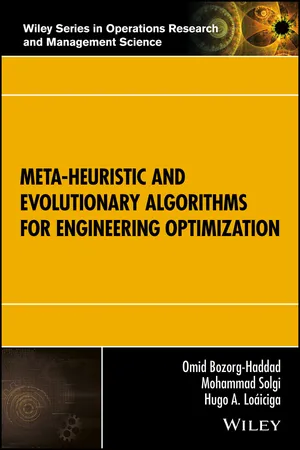
Meta-heuristic and Evolutionary Algorithms for Engineering Optimization
- English
- ePUB (mobile friendly)
- Available on iOS & Android
Meta-heuristic and Evolutionary Algorithms for Engineering Optimization
About this book
A detailed review of a wide range of meta-heuristic and evolutionary algorithms in a systematic manner and how they relate to engineering optimization problems
This book introduces the main metaheuristic algorithms and their applications in optimization. It describes 20 leading meta-heuristic and evolutionary algorithms and presents discussions and assessments of their performance in solving optimization problems from several fields of engineering. The book features clear and concise principles and presents detailed descriptions of leading methods such as the pattern search (PS) algorithm, the genetic algorithm (GA), the simulated annealing (SA) algorithm, the Tabu search (TS) algorithm, the ant colony optimization (ACO), and the particle swarm optimization (PSO) technique.
Chapter 1 of Meta-heuristic and Evolutionary Algorithms for Engineering Optimization provides an overview of optimization and defines it by presenting examples of optimization problems in different engineering domains. Chapter 2 presents an introduction to meta-heuristic and evolutionary algorithms and links them to engineering problems. Chapters 3 to 22 are each devoted to a separate algorithm— and they each start with a brief literature review of the development of the algorithm, and its applications to engineering problems. The principles, steps, and execution of the algorithms are described in detail, and a pseudo code of the algorithm is presented, which serves as a guideline for coding the algorithm to solve specific applications. This book:
- Introduces state-of-the-art metaheuristic algorithms and their applications to engineering optimization;
- Fills a gap in the current literature by compiling and explaining the various meta-heuristic and evolutionary algorithms in a clear and systematic manner;
- Provides a step-by-step presentation of each algorithm and guidelines for practical implementation and coding of algorithms;
- Discusses and assesses the performance of metaheuristic algorithms in multiple problems from many fields of engineering;
- Relates optimization algorithms to engineering problems employing a unifying approach.
Meta-heuristic and Evolutionary Algorithms for Engineering Optimization is a reference intended for students, engineers, researchers, and instructors in the fields of industrial engineering, operations research, optimization/mathematics, engineering optimization, and computer science.
OMID BOZORG-HADDAD, PhD, is Professor in the Department of Irrigation and Reclamation Engineering at the University of Tehran, Iran.
MOHAMMAD SOLGI, M.Sc., is Teacher Assistant for M.Sc. courses at the University of Tehran, Iran.
HUGO A. LOÁICIGA, PhD, is Professor in the Department of Geography at the University of California, Santa Barbara, United States of America.
Frequently asked questions
- Essential is ideal for learners and professionals who enjoy exploring a wide range of subjects. Access the Essential Library with 800,000+ trusted titles and best-sellers across business, personal growth, and the humanities. Includes unlimited reading time and Standard Read Aloud voice.
- Complete: Perfect for advanced learners and researchers needing full, unrestricted access. Unlock 1.4M+ books across hundreds of subjects, including academic and specialized titles. The Complete Plan also includes advanced features like Premium Read Aloud and Research Assistant.
Please note we cannot support devices running on iOS 13 and Android 7 or earlier. Learn more about using the app.
Information
1
Overview of Optimization
Summary
1.1 Optimization





1.1.1 Objective Function
1.1.2 Decision Variables
Table of contents
- Cover
- Title Page
- Table of Contents
- Preface
- About the Authors
- List of Figures
- 1 Overview of Optimization
- 2 Introduction to Meta‐Heuristic and Evolutionary Algorithms
- 3 Pattern Search
- 4 Genetic Algorithm
- 5 Simulated Annealing
- 6 Tabu Search
- 7 Ant Colony Optimization
- 8 Particle Swarm Optimization
- 9 Differential Evolution
- 10 Harmony Search
- 11 Shuffled Frog‐Leaping Algorithm
- 12 Honey‐Bee Mating Optimization
- 13 Invasive Weed Optimization
- 14 Central Force Optimization
- 15 Biogeography‐Based Optimization
- 16 Firefly Algorithm
- 17 Gravity Search Algorithm
- 18 Bat Algorithm
- 19 Plant Propagation Algorithm
- 20 Water Cycle Algorithm
- 21 Symbiotic Organisms Search
- 22 Comprehensive Evolutionary Algorithm
- Wiley Series in Operations Research and Management Science
- Index
- End User License Agreement